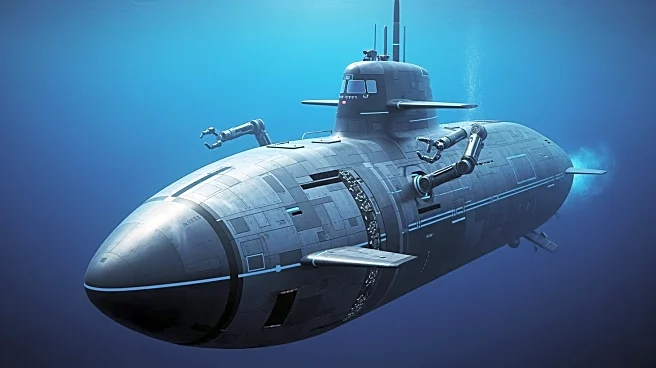What's Happening?
Russia's Ministry of Defence announced the launch of its nuclear-powered submarine Khabarovsk on November 1, 2025, at the Sevmash shipyard in Severodvinsk. The submarine, designed by Rubin Central Design
Bureau for Marine Engineering, is intended to carry out naval tasks using modern underwater weaponry, including various types of robotic systems. The Khabarovsk is described as a heavy nuclear missile submarine and is based on the design of the Dolgorukiy-class ballistic missile submarines. The development and construction of the submarine have been shrouded in secrecy, with only limited imagery released by the Russian MoD. The vessel is approximately 136 meters in length and features a conventional design. The launch event was attended by several high-ranking officials, including Minister of Defence Andrey Belousov and Admiral Alexander Moiseyev, commander-in-chief of the navy.
Why It's Important?
The launch of the Khabarovsk submarine represents a significant advancement in Russia's naval capabilities, particularly in the realm of underwater robotic systems. This development could potentially alter the strategic balance in naval warfare, as robotic systems may enhance the submarine's operational effectiveness and stealth capabilities. The introduction of such advanced technology raises concerns among U.S. defense analysts and policymakers about the implications for global security and the potential need for countermeasures. The submarine's capabilities could impact U.S. naval strategy and defense planning, prompting discussions on the modernization of U.S. naval forces to maintain strategic parity.
What's Next?
The Khabarovsk submarine is set to undergo a cycle of sea trials to test its capabilities and ensure operational readiness. These trials will be crucial in determining the effectiveness of the submarine's robotic systems and its integration into the Russian navy. The U.S. and its allies may closely monitor these developments, potentially leading to increased diplomatic and military engagements to address the strategic implications. Additionally, the U.S. defense industry might accelerate research and development efforts to counteract the advancements in Russian naval technology.
Beyond the Headlines
The launch of the Khabarovsk submarine highlights the growing importance of robotic systems in modern warfare, particularly in naval operations. This shift towards automation and advanced technology could lead to ethical and legal debates regarding the use of autonomous systems in combat. Furthermore, the secrecy surrounding the submarine's development underscores the challenges in intelligence gathering and the need for enhanced surveillance capabilities to monitor foreign military advancements.












